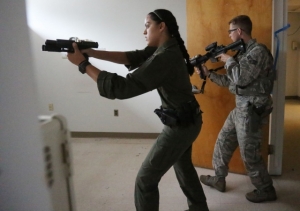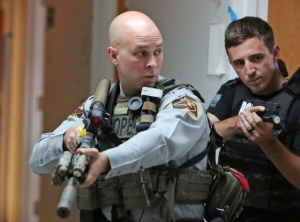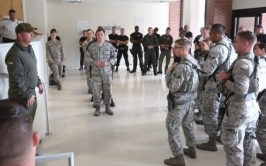Training for crisis
By Sierra Henry
Published in News on July 22, 2018 3:05 AM

News-Argus/CASEY MOZINGO
Maryssa Ebersole, from the Wayne County Sheriff's Office, and Senior Airman Marcus Sensabaugh, Seymour Johnson Security Forces, clear a room during Friday's joint training.

News-Argus/CASEY MOZINGO
Adam Fowler, with the N.C. Highway Patrol, and Garrett Childs, with the Goldsboro Police Department, work together to clear rooms ahead of their team during a training on how to safely rescue victims following an active shooter.

News-Argus/CASEY MOZINGO
Lt. Rex Hatch, at left, from the Wayne County Sheriff's Office, talks about formations during a morning briefing Friday in the old medical facility at Seymour Johnson Air Force Base.
Local law enforcement, emergency personnel, firefighters and airmen suited up and engaged in an active shooter drill at Seymour Johnson Air Force Base Friday morning.
Just one day after a well-attended Crisis Preparedness, Response and Communications training in the city, area first responders took the training to the next level by working through drills and possible real-life scenarios that could take place during a mass shooting or other life-threatening crisis in the Wayne County area.
"We, as a community, need to have a plan," said Fire Chief Sean Quinby, with the Seymour Johnson AFB 4th Civil Engineer Squadron. "With the way resources are so constrained these days, everybody has to be a part of this, and there's no way community or fire or police or law enforcement can, by themselves, handle these disasters. It takes more resources . . ."
"We can't say it's not going to happen here. It happened at Wayne Community College. So, our community has been affected."
On the morning of April 13, 2015, the campus and surrounding roads went into lockdown following the fatal shooting of Ron Lane, a campus print shop technician. A manhunt resulted in the arrest of Kenneth Stancil III, who was later convicted of first-degree murder, in 2017.
The training, the seventh to take place this year, was held at the former Fourth Medical Clinic on base. Goldsboro police, firefighters, emergency medical service personnel, sheriff deputies, a SWAT team and state highway patrolman participated in the excercize, in collaboration with base personnel.
"The basic thing is just being able to work with another agency, another officer, another EMS person that you've never met, spoken to," said Lt. Rex Hatch, with the Wayne County Sherriff's Office. "But because of the training you get together, you have the same foundation of knowledge and can get the job done."
Active shooter drills were first created to specifically focus on rescuing injured persons, who are often left while law enforcement work to neutralize any threat," Hatch said.
"We've seen so many times that people bleed out and die waiting to be helped, and that's what this training is all about -- being able to get to the injured and get them out so that they can be transported to the hospital or someone with higher knowledge of medical first aid (who can) take care of them," Hatch said.
"The biggest thing is knowing we're able to handle it, if it does happen, and the injured people that are laying there waiting for us to get them can have faith in knowing, hey, we're on the way, we're trained for this, and we're going to do our best to get to you and get you home."
Hatch, who attended the Crisis Preparedness, Response and Communications Symposium Thursday at the Maxwell Center, said the active shooter drill on base showed him there is more work to be done between law enforcement officers to prepare and train for crisis situations.
The need for collaboration is apparent at the beginning of the training sessions, he said, when people are reluctant to talk to those who are not in their department.
"Initially, when people get together, they don't want to talk . . .," Hatch said. "By the end of the training, they have learned how to communicate with each other, how to move with each other, and they actually become a unit."
Mike Clumpner, president and chief executive officer of Threat Suppression, a public safety training firm, who spoke at Thursday's symposium, was able to attend the active shooter training at Seymour Johnson AFB. He was able to help walk groups through the training and answered questions law enforcement had, as far as what they should do or how to best prepare for an active shooter.
The training exercise was important for airmen as well as local first responders to better define the roles each could play during a crisis situation, whether it be at a school on base or anywhere else, Quinby said. He also said that training and learning how to work together is one way law enforcement agencies can prepare for an active shooter.
In the case of a shooting, there would not be time to coordinate response teams that frequently work together.
"On the scene, when this actually happens, they're going to have to go in and save lives with people they don't know," he said.
"No community is fully prepared. If they think they're fully prepared, they're lying to themselves. Even after all this training, if we do this training over and over for years at a time, if we think we're fully prepared, that's letting our guard down. We have to keep training."
